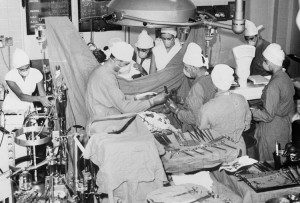50 Years Ago : First Human Heart Transplant
Friday, December 1st, 2017December 1, 2017
South African surgeon Christiaan Barnard electrified the world 50 years ago on Dec. 3, 1967, by performing the first successful human heart transplant. On that day, Barnard removed the dying heart of Louis Washkansky and replaced it with a healthy one taken from an accident victim. The operation took place at Groote Schuur Hospital in Cape Town, South Africa. Barnard’s surgical skill and daring—combined with his telegenic looks and ready wit—catapulted him overnight into the role of international celebrity. Newspapers and television interviewers scrambled to hear his expert opinion on most everything from health and physical fitness to science to global politics.

The South African surgeon Christiaan Barnard, seen at the center of this photo among his surgical team, performs open heart surgery in Cape Town in 1967. Later that year, Barnard performed the first human heart transplant operation. Credit: © Corbis/Bettmann
Prior to Barnard’s accomplishment, surgeons in Europe and the United States—including pioneering American heart surgeon Norman Shumway—had experimented with several techniques to perform a human heart transplant but had met with little success. In 1967, Barnard was presented with a unique scientific opportunity. Denise Darvall, a 25-year-old office clerk, was unfortunately struck by an automobile in Cape Town. She was rushed to Groote Schuur Hospital, where her brain was found to be clinically dead. However, her still-beating heart was in good condition, and she had the same blood type as Washkansky, an ailing 54-year-old Lithuanian-born grocer. The successful operation took about six hours to complete.
Organ transplant surgery is difficult for even the most skilled surgeons and is prone to complications. The first truly successful human organ transplant operation was done in 1954, when doctors in Boston transplanted a kidney from one person to his identical twin. Because the donor and recipient were genetically identical, there was no danger the transplanted organ would be attacked by the recipient’s immune system. Doctors refer to this complication as organ rejection. The risk of rejection affecting a vital organ such as the heart posed a daunting challenge for surgeons. Washkansky was vulnerable to infection from the large doses of drugs and radiation used to suppress his immune system and prevent organ rejection. He died of pneumonia 18 days after the operation, but his heart functioned normally until his death.
In the United States and Europe, the prospect of heart transplant operations also raised many ethical, moral, and legal considerations. Because the donor’s heart must be transplanted immediately, the problem of determining the exact moment of death was debated by physicians and lawyers. In the United States, death was normally defined as when a person’s heart stopped. Law enforcement officials threatened to arrest surgeons who took organs from brain-dead individuals while the heart remained beating. The delay often led to tissue damage and decreased the chances of a successful transplant operation. Barnard’s success with a brain-dead victim as a heart donor made the practice more acceptable for future organ transplants worldwide.
A month later, on Jan. 2, 1968, Barnard caused a new sensation in racially segregated South Africa by transplanting the heart of a young man of mixed race into a white man. The recipient survived for 19 months and 15 days, in part because Barnard’s team had reduced the amount of antirejection drugs the patient received. Over the years, surgical techniques have been improved and new antirejection drugs have been developed. Today, about 3,000 human heart transplant operations are performed each year in the United States, and about 5,000 are performed annually worldwide.


